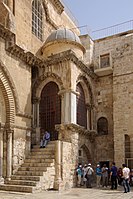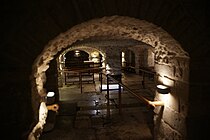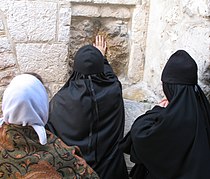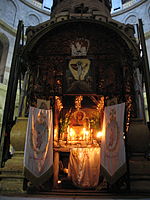The Via Dolorosa or Via crucis (Way of the Cross) is a processional route that has been used since the Middle Ages Old City of Jerusalem leads along the path of suffering of Jesus Christ.

Not just the Roman Catholic Jerusalem- Pilgrims like to take this path at the end of their pilgrimage, due to the sights from antiquity to the Middle Ages Via Dolorosa for many visitors from Jerusalem an important part of the travel program.

Processions are organized by the Franciscans on Fridays; individual groups of pilgrims are almost always on the move here. Some complete the Way of the Cross in silent devotion, other groups re-enact the ordeal more or less "ready for a film".
background

Apparently it was Way of the Cross devotion, on which stages on the ordeal of Christ between judgment and death on the cross are commemorated at various stations, already popular in Europe in the Middle Ages. European pilgrims brought the concern to Jerusalem to be able to walk the processional way on the historical sites.
The processions on the Via Dolorosa have their origins in the time of the Crusaders. At that time the place of the condemnation of Christ (the "Praetorium") was presumed to be in the area of the Roman fortress Antonia. Based on descriptions by the Roman - Jewish historian Flavius Josephus, the fortress Antonia von Theodericus, located on the northwest corner of the Temple Mount, was located around 1172. Since then, this has been the starting point of the Via Dolorosa processions, even if the praetorium was at a different location in the old town in Roman times.
After the Muslim conquest by Saladin in 1187, Christians were forbidden to cross the Temple Mount. The places of the first stations as presumed places of the flagellation of Christ, etc. remained in the consciousness of the pilgrims. In 1838 the Franciscans were able to acquire the area of the flagellation of Christ ("Flegellatio") and build a chapel here. In the 19th century, the importance of a presence in the Holy City gained importance not only among the Habsburgs, but also among other European rulers. Various buildings were acquired for the construction of residences in Jerusalem.
The one committed today Via Dolorosa is a processional way in commemoration of the sufferings of Jesus Christ, but since the locations of the biblical events are not known, it is not a historical walk in the footsteps of Jesus. Not only was the "Praetorium" assigned an incorrect location, but also the location of the crucifixion and burial of Jesus could never be precisely identified. The pilgrimage sites up to the Church of the Holy Sepulcher are more evidence of a Christian tradition that has existed since the fourth century than is historically secured. Many traditions are based on the knowledge that Helena, the mother of the Roman emperor Constantine, who had made Christianity the state religion in the Roman Empire, won on her pilgrimage to Rome in 326. However, the imperial mother, who was somewhat religious and believing in relics, may have believed some legends that did not fully correspond to the truth. The efforts of the Roman Emperor Hadrian to destroy traces of "heretical" (ie Jewish and Christian) piety and veneration after the Roman conquest of Rome meant that certain places could no longer be visited by believers, and only memories of them were left was able to last for almost two centuries.
Even if the truthfulness of the countless legends circulating in the ancient walls of Jerusalem can rarely be verified, it is worthwhile for the visitor to follow the places of centuries of veneration and to immerse themselves in the world of medieval piety.
preparation
From the Franciscans on Friday around 3 p.m. (during the summer at 4 p.m.) a procession is organized, on which the pilgrims, laden with wooden crosses, can relive the Passion of Christ. The first station is only open to the public on this occasion.
getting there
As a rule, pilgrims start the Via Dolorosa from 1 Lion gate here. There are limited parking spaces here.
On the Via Dolorosa

By the Lion gate (or Stephanstor in Christian and Bab Al-Miryam in Arabic) you enter the Arab quarter in the northeast of the old town. The Lion's Gate St. runs in a westerly direction until it is named after the first station of the cross Via Dolorosa receives.
- The distance of approx. 600 m in length can be comfortably covered on foot.
Station I: Antonia Fortress

The first station commemorates the condemnation of Jesus to death on the cross by Pontius Pilate. According to the biblical report (Joh 18,28 ) occurred in the Praetorium. This governor's seat was probably in a different location in the old town and not in the Antonia fortress. Theodericus was probably wrong in the twelfth century when he located the seat of Pontius Pilate in the fortress Antonia.
In the courtyard of the Muslim girls' school Omariya or Al Umariya, foundations can be seen in the south of the courtyard that belonged to the Antonia fortress. The first station of the Catholic version of the Via Dolorosa can only be visited here on Friday, when the school is closed, in connection with the procession of the Franciscans. The round metal plaque with the number I marks the place on the access ramp to the girls' school, where the first station of the cross is commemorated on the other days of the week.
According to the account in John 13 (Joh 19,13 ) was Pontius Pilate in the paved courtyard Lithostrothos or forum sat in court (see below: Ecce Homo sheet).
Station II: The cross is imposed on Jesus

A semicircular paving on the street and a round metal plaque with the II mark the second station of the Way of the Cross. At this point, one commemorates how Jesus was loaded on the cross.
An entrance leads into an inner courtyard of the monastery of the Flagellation ("Sanctuary of the Flagellation"). On the left is the Church of the Comdemnation. On the right is the Church of the Flagellation.
In the Church of Condemnation, which was built in 1903 on the foundations of an older Byzantine building, there are some old stone blocks of the Lithostrothos receive. This stone-paved courtyard was laid out under Emperor Hadrian in the area of the forum of the Roman city of Aelia Julia Capitolina (the name of Jerusalem was to be forgotten). The rainwater is collected and fed to the cistern below, the so-called Struthion pond.
The medieval construction of the Flagellation Church had to be abandoned in 1618. Ibrahim Pasha returned the ruins to the Franciscans in 1838. The church was renovated in 1929. The crown of thorns is depicted on the dome above the chancel. Three stained glass windows by Cambelotti show the flagellation, Pilate washing his hands and Barabbas who was acquitted.
In the area behind the Flagellation Church is the Studium Biblicum Franciscanum, a biblical - archaeological research center of the Franciscan Order. That is in the premises of the Flagellation Monastery Terra Sancta Museum housed. A multimedia show reports on the history of the Via Dolorosa.
- Terra Sancta Museum, Convento della Flagellazione, Via Dolorosa 1. Open: summer 9 a.m. - 6 p.m., winter 9 a.m. - 5 p.m.Price: 15 NIS.
Ecce Homo - bow
4 Ecce Homo bow

The Ecce Homo bow is part of a triumphal arch that the Roman Emperor Hadrian probably had built. Part of the 8 m high main arch forms the large semi-arch over the Via Dolorosa. The northern arch is in the sanctuary of the Ecce Homo Basilica away.
The Ecce Homo Basilica was built at the place where, according to tradition, Pontius Pilate presented Jesus Christ with a crown of thorns and a royal cloak to the crowd with the words "Ecce Homo" (Latin: "See what a person"), whereupon the crowd introduced his Death demanded. The basilica and the associated monastery ("Ecce Homo Monastery" or "Monastery of the Sisters of Zion") were built in 1857 by Alphonse Ratisbonne, a French Jew who converted to Catholicism, on an acquired rubble plot.
Below these buildings are the Roman structures of the Struthion pond (a cistern, covered during the renovations under Emperor Hadrian) and a piece of the paving of the market square / forum (Lithostrothos) with a carved Roman game that soldiers use to track time expelled to see.
- 5 Ecce Homo Convent, Notre Dame de Sion, Via Dolorosa 41, 91190 Jerusalem. Tel.: 972 (0)2 627 7292, Email: [email protected]. Archaeological site which includes the Struthion Pond, the paving of the ancient forum and a small museum.Open: 8 a.m. to 5 p.m.
Right next door is the Greek Orthodox one 6 Praitorion (Church of Praetorium). Three grave caves from the time of the First Temple may have been used as a dungeon for criminals in Roman times. In any case, at the beginning of the 20th century, a cell was prepared as a chapel for the devotion to Jesus' time in prison.
This is where the Via Dolorosa begins for the Greek Orthodox pilgrims.
Station III: Jesus falls for the first time
7 Station III: first fall of Jesus
.jpg/210px-תחנה_3_בדרך_הייסורים_(2).jpg)
At the location of the third station, Jesus is said to have stumbled under the weight of the cross for the first time. However, this incident is not reported in the Bible.
The chapel in this place is called the Polish Catholic Chapel. It was established by Catholic Armenians living in Poland in the 19th century. built. In 1947/48 the renovation was carried out with financial support from members of the Polish army.
The 1 Austrian pilgrims' hospice on the other side of the street was the center of Austria's presence in the Orient until 1918. It offers overnight accommodation in rooms and dormitories as well as Austrian specialties such as Sachertorte and apple strudel; Above all, there is a fantastic view of the old town from the roof.
- Austrian hospice for the Holy Family (Austrian Hospice), Via Dolorosa 37. Tel.: 972-2-6265800, Fax: 972-2-6271472, Email: [email protected].
Station IV: Jesus meets his mother
8 Station IV: Jesus meets Mary
;_1-3000-306.jpg/210px-East_Jerusalem_(The_Fourth_Station_of_Jesus_on_Via_Dolorosa);_1-3000-306.jpg)
According to legend, an encounter between Mary and Jesus took place at the location of the fourth station on the way to the crucifixion. Nothing is reported in the Bible about this incident either.
The Church of Our Lady of Sorrows or Chapel of the Faint of Our Lady (Our Lady of the Spasm / Spasimo del Virgine) refers to the non-biblical event that Mary passed out from the pain of the encounter. A floor mosaic in the crypt of the church comes from the 4th / 6th centuries. Century from a Byzantine church. In the time of the crusaders there is reports of a church. The complex was later built over with the Turkish bath house Hammam al-Sultan.
The Armenian Catholic Church, which recognizes the Pope as head of the church, was able to purchase the building in 1876 and build the current church in 1881, with the remains of a medieval building being used as a crypt. The exit is in a side chapel.
Until about 2008, the IV. Station was located a little further south on the corner of Barquq Street.
Station V: Simon of Cyrene picks up the cross
9 Station V: Simon of Cyrene picks up the cross
.jpg/210px-20110224_0396_Jerusalem_(5539900851).jpg)
At the location of the fifth station, a Franciscan chapel from 1895 marks the place where Simon of Cyrene removed the heavy cross from Jesus (Lk 23,26 ), as the Latin inscription says. The chapel and the stone on which Jesus is said to have supported himself with his hand and left a handprint are located at the intersection of Al-Wad Street / Via Dolorosa.
Station VI: Veronica's handkerchief
10 Station VI: Veronica's handkerchief

At the location of the sixth station, at the location of the chapel built by the Melkite Greek Catholic Patriarchate in 1883 and the monastery of the Little Sisters of Jesus, Veronica is said to have handed Jesus the handkerchief on which a facial imprint was miraculously preserved.
The Melkite-Greek chapel was built on the ruins of the Cosmas monastery from the time of the Crusaders. Some arches date from the 12th century.
Station VII: Jesus falls the second time
11 Station VII: Jesus falls the second time

The place of the seventh station is, according to tradition, the place of the second fall of Jesus on the way to the place of execution. It is located at the intersection of Via Dolorosa / Souq Khan Ez-Zeit. In ancient times this was the most important intersection of the Roman roads Cardo and Decumanus. From Tetrapylon - A building that marks the main crossroads of a Roman city and consists of many square columns with a roof with a frieze - remains are still preserved.
Legend has it that the Souq Khan Ez-Zeit street led to the "Gate of Judgment" and out to the crucifixion site of Golgotha. Until the end of the 17th century. the Via crucis ended here.
Station VIII: Jesus meets Jerusalem women
12 Station VIII: Jesus meets Jerusalem women

At the eighth station there is a Marking cross with the words IC XC NIKA (Jesus Christ is victor) in the wall of the Greek Orthodox monastery of St. Charambalos at the back of the Church of the Holy Sepulcher on El Khanqa Street.
Here the meeting of Jesus with the believing Jerusalem women (Lk 23,27-31 ) have taken place.
You have to turn around here. The path continues on Souk Khan Ez-Zeit Street, where after a few meters to the right the (often missed) staircase to IX. Station of the Cross / roof of the Church of the Holy Sepulcher.
Station IX: Jesus falls the third time
13 Station IX: Jesus falls the third time

The ninth station is in front of the Coptic Orthodox Church of St. Helena. According to tradition, Jesus is here fallen for the third time. The place of this station of the cross used to be on the forecourt of the Holy Sepulcher.
With a little luck you will find the door open and you can visit the church and the cistern under the church, which can be reached via a narrow staircase.
The entrance through the portal, which is also provided with a green arch, leads to the Ethiopian-Orthodox Monastery Deir es-Sultan and the Coptic-Orthodox Monastery of St. Antonius, now you can actually find yourself on the roof of the St. Helena Chapel of the Church of the Holy Sepulcher (whose dome from the square). When the gate is open, one can go on to the poor dwellings of the monastery of the Ethiopian Orthodox monastery on the roof of the Church of the Holy Sepulcher.
A low door ("Mind your head") opposite the entrance on the other side of the square is open - if you're still lucky - and you can continue through a narrow corridor through the chapels of the Coptic monastery and suddenly stand on the forecourt of the Church of the Holy Sepulcher. This passage is only possible for individuals.
The path taken by groups leads from the IX. station back again on Souk Khan Ez-Zeit Street. Take the next junction to the right and in an alley past the Muristan market to the entrance to the Church of the Holy Sepulcher (called "Church of the Holy Sepulcher")
Station X: place where clothes are distributed
14 Station X: Place of distribution of clothes

At the tenth station, the Frankenkapelle or Chapel of the distribution of clothes next to the walled-up entrance to the Church of the Holy Sepulcher, one remembers how Jesus' clothes were removed before his crucifixion and the Roman soldiers rolled for it (Lk 23,34 ).
The other / last stations are inside the Holy Sepulcher:
Church of the Sepulcher


- 15 Church of the Holy Sepulcher, engl. Church of the Holy Sepulcher. Open: summer 5:00 a.m. - 9:00 p.m., winter 4:00 a.m. - 7:00 p.m.Price: Free entry.
The complex of Holy Sepulcher is actually a tangle of churches and chapels of different Christian denominations, which are grouped around the place where, according to tradition, the crucifixion site Golgotha and the tomb of Jesus Christ should have been. The real place where it all happened Golgotha (bebr .: place of the skull) is not historically secured. It can be assumed that the place of execution was outside the former city wall of Jerusalem had been lying. In Roman times, the wall ran differently than the city wall from the Middle Ages that is still in existence today.
The history of the house of God in the area of the crucifixion and burial site of Jesus Christ begins with the search for the biblical site of Golgotha Helena, mother of the Emperor Constantine, who in 327 was on a pilgrimage to the Holy city identified the remains of the crucifixion site among the ruins of a Roman shrine to Venus. Legend has it that she found three crosses in an ancient cistern. The real one was identified through a healing miracle. There were also three nails from the nailing of Christ and the "titulus", the plate with the inscription INRI, which made known the crucifixion of Christ (Jesus Christ King of the Jews). The cross was cut into three parts and transferred to Rome and Constantinople. A little later, the veneration of cross relics spread throughout the Catholic world. Under Emperor Constantine was a first Holy Sepulcher erected and consecrated on Sept. 13, 335. The first system consisted of a rotunda (round pillars covered by a dome) around the aedicula (temple-like shrine) above the Holy Sepulcher, an entrance portico (pillared hall) and a basilica to the east. The Golgotha rock was in the area under the open sky.
After the Islamic rulers had spared the Christian sites for a long time after the defeat of the Byzantines, the Church of the Holy Sepulcher and the rock tomb, which had been largely intact until then, were largely destroyed in 1009 by the Fatimid caliph Al-Hakim, which was the main trigger for efforts to "liberate the Holy Land" in Europe and thus the Crusades was. After the recapture of Jerusalem by the Crusaders, the Church of the Holy Sepulcher was rebuilt and, instead of the basilica, a nave was built with covering also the rock of Golgotha, which essentially corresponds to the church that still exists today.
Under Muslim rule, the church was preserved through the Middle Ages. The since Church division Roman Catholic Franciscans or the Greek Orthodox Church alternated with domination over the Church of the Holy Sepulcher, depending on which denomination was able to win the favor of Ottoman rule (not least through bribery). With a definitive decree from the Sultan in 1852, the one that is still valid today Status quo for the use of the Holy Sepulcher under the denominations.
Station XI: Cross nailing chapel
16 Station XI: Cross nailing chapel

At the eleventh station, the nailing of the cross is thought of. The Roman Catholic chapel can be reached inside the Church of the Holy Sepulcher if you climb the stairs to the upper floor to the Golgotha rock immediately to the right after the entrance and the guard's lodge.
Station XII: Place of the Crucifixion
17 Station XII: Place of the Crucifixion

Above that Rock of Calvary the neighboring Greek Orthodox Crucifixion Chapel, separated by columns, was built, which represents the twelfth station. A hole under the altar denotes the Place where the cross of Jesus stood. Especially the Orthodox believers bend down under the age and kiss the place.
Back down the stairs to the entrance hall.
Station XIII: Stabat mater - statue / anointing stone
18 Station XIII: Anointing Stone

Classically, the thirteenth station was at the Stabat Mater statue between the two chapels on the rock of Golgotha (XI / XII. Station). Mary, the mother of Jesus, is said to have stood here (Latin: "stabat mater", the mother stood).
Most processions seek the thirteenth station Anointing stone in the area of the entrance to the Church of the Holy Sepulcher. The body of Jesus was anointed on this stone after being deposed from the cross before burial. It is covered with a stone slab on which some believers pour oil, only to skim it off afterwards or dab it with a cloth and take it with them.
Station XIV: The Holy Sepulcher
19 Station XIV: The Holy Sepulcher
.jpg/148px-Jerusalem_Batch_1_(883).jpg)

To the left you turn to rotunda, in the center of which the Holy grave lies.
The holy tomb is of a Turkish-Baroque style Aedicula overbuilt. This "structure" under the huge dome of the rotunda was recently renovated.
In front of the Holy Sepulcher is the Angel Chapel, which can be entered by a maximum of seven people in order to wait for admission to the burial chamber. While waiting you can see the stone on which the angel was sitting (Matth 28,2 ), who announced the resurrection of Jesus to the two Marys.
In the real Burial chamber there is only room for about three people each. The empty tomb represents the XIV. Station the Via Dolorosa. A marble slab denotes the place where the body of Jesus was laid when he was buried. In the burial chamber, with the rock on which the body of Jesus is said to have been lying, and which is always closed on Good Friday, the Greek Orthodox Patriarch lights it on Easter vigil in front of hundreds of pilgrims who have come for the occasion Easter light.
To the Head of the stone, on which the body of Jesus is said to have been lying, and which is separated from the burial chamber by a wall, can be reached through the rotunda from the rear. A Coptic monk usually sits here in a small chapel as a guard of honor at the head of the Christ tomb.
(Station XV: Resurrection Chapel)
Station XV: Roman Catholic Resurrection Chapel
The Roman Catholic Resurrection Chapel was named as a possible fifteenth station after the Holy Sepulcher. After commemorating the death of Jesus Christ, the believer should find a place of new hope here with the commemoration of the work of redemption on the cross.
security
If you want to fully experience the mood of devout veneration, go to Jerusalem at the time of the Roman Catholic or Orthodox Easter. Worst of all is the crowd on Via Dolorosa on Good Friday. Then claustrophobia can have problems in the crowd. Outside of these main pilgrimage times, we recommend a visit to the Church of the Holy Sepulcher in the early morning or before the end of the closing time in the evening for visitors who need rest.
Especially when the Roman Catholic and Orthodox Easter holidays fall on the same date, there have already been violent disputes and tumult among the Catholic and Orthodox monks within the Church of the Holy Sepulcher. The Israeli police are present with a post on the south side of the forecourt of the Church of the Holy Sepulcher. On days with a high flow of pilgrims, the visitors are guided around the aedicula with barriers in a "one-way direction". Then you have to practice standing in line.
trips
- Immediately to the left / in the west of the forecourt of the Church of the Holy Sepulcher is the entrance to the Orthodox chapels of the 40 martyrs and the St. James' Church.
- Well worth a visit to Gethsemane and the Church of the Nations at the foot of the Mount of Olives.





.jpg/210px-20110224_0346_Jerusalem_(5539888315).jpg)
.jpg/210px-Church_of_the_Flagellation._Jerusalem_(5539887519).jpg)


.png/210px-Arch_of_Ecce_Homo_in_Jerusalem_(Vincent,_Louis-Hugues,_Jérusalem,_recherches_de_topographie,_d'archéologie_et_d'histoire_-_II,_Paris,_1912,_p._25).png)



.jpg/210px-thumbnail.jpg)









.JPG/210px-Chapel_in_7th_Station_(Via_Dolorosa).JPG)














